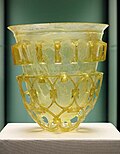Tin-glazing is the process of giving tin-glazed pottery items a ceramic glaze that is white, glossy and opaque, which is normally applied to red or buff...
27 KB (3,760 words) - 13:33, 4 August 2024
Tin-glazed pottery is earthenware covered in lead glaze with added tin oxide which is white, shiny and opaque (see tin-glazing for the chemistry); usually...
25 KB (3,362 words) - 00:32, 19 May 2024
earthenware, sanitaryware and wall tiles; see the articles tin-glazing and Tin-glazed pottery. Tin oxide remains in suspension in vitreous matrix of the fired...
15 KB (1,500 words) - 02:45, 19 February 2024
Glazing, which derives from the Middle English for 'glass', is a part of a wall or window, made of glass. Glazing also describes the work done by a professional...
13 KB (1,689 words) - 10:16, 28 June 2024
Maiolica (section Tin-glazed earthenware)
The term "maiolica" is sometimes applied to modern tin-glazed ware made by studio potters. Tin glazing creates a white, opaque surface for painting. The...
20 KB (2,591 words) - 00:15, 19 May 2024
is commonly known as double glazing or a double-paned window, triple glazing or a triple-paned window, or quadruple glazing or a quadruple-paned window...
34 KB (4,232 words) - 08:23, 29 July 2024
Majolica (section Tin-glazed earthenware)
Majolica Murders by Deborah Morgan Lustreware Talavera de la Reina pottery Tin-glazing Victorian majolica Arthur Beckwith, 1877, Majolica and Fayence, Italian...
21 KB (2,359 words) - 08:06, 5 May 2024
Architectural glass (redirect from Glazing in construction)
used as a building material. It is most typically used as transparent glazing material in the building envelope, including windows in the external walls...
30 KB (3,877 words) - 18:40, 22 August 2024
Fritware was invented to give a strong white body, which, combined with tin-glazing of the surface, allowed it to approximate the result of Chinese porcelain...
15 KB (1,764 words) - 03:14, 9 June 2024
Ceramic glaze (redirect from Glazing (ceramics))
pottery, usually in the form of elaborate pottery.[citation needed] Tin-opacified glazing was one of the earliest new technologies developed by the Islamic...
24 KB (2,863 words) - 08:04, 18 May 2024
theories of metallic composition until the eighteenth century. Tin-glazing: The earliest tin-glazed pottery appears to have been made in Abbasid Iraq/Mesopotamia...
81 KB (9,285 words) - 04:17, 4 August 2024
century – Porcelain is invented in Tang dynasty China 8th century – Tin-glazing of ceramics invented by Muslim chemists and potters in Basra, Iraq: 1 ...
10 KB (1,012 words) - 18:23, 8 August 2024
Egyptian faience (section Glazing technology)
Cementation glazing, a technique discovered in the Middle Kingdom, is also a self-glazing technique. The possibility of the existence of cementation glazing, also...
40 KB (4,559 words) - 22:04, 3 June 2024
Ceramic art (section Tin-glazed pottery)
elaborate decoration. It introduced tin-glazing to Europe, which was developed in the Italian Renaissance in maiolica. Tin-glazed pottery was taken up in the...
81 KB (9,464 words) - 08:12, 23 August 2024
wheel and tin-glazing. These new methods were mixed with native designs to give rise to what became known as Poblano Talavera. The glazing technique was...
78 KB (8,228 words) - 09:42, 22 August 2024
increased the quality and quantity that porcelain could be produced. Tin-glazing of ceramics is invented by Arabic chemists and potters in Basra, Iraq...
29 KB (3,508 words) - 13:36, 10 September 2024
al Lambro, rich in silicon, but tin was also added to the glaze. Tin-glazing made the ceramics uniform. Having a tin based glaze, Lodi ceramics are to...
17 KB (1,955 words) - 16:22, 2 April 2024
of glazing agent for confectionery and dried fruit, and processing aid uses as a lubricant and release agent, especially in bread baking using tins. It...
2 KB (161 words) - 18:44, 8 March 2022
produced at Ipsen's Terracotta Factory. She experimented with thick tin-glazing in greyish white tones as in her lidded dish (Laagfad, 1913) and flowered...
5 KB (545 words) - 18:47, 31 August 2023
them with a white glaze rendered opaque by the addition of tin, an early example of tin-glazing. This distinct shape was another characteristic adopted from...
31 KB (3,423 words) - 23:31, 18 May 2024
and today for tourists. In the 19th century two glazing techniques revived by Minton were: 1. Tin-glazed pottery in the style of Renaissance Italian...
19 KB (2,200 words) - 08:10, 21 August 2024
Blue (Dutch: Delfts blauw) or as delf, is a general term now used for Dutch tin-glazed earthenware, a form of faience. Most of it is blue and white pottery...
14 KB (1,609 words) - 07:43, 21 May 2024
rapid large changes in temperature, as commonly occur in cooking, and the glazing of earthenware often contains lead, which is poisonous. Thompson noted...
29 KB (3,378 words) - 06:45, 31 July 2024
of faience, a pre-glass vitreous material made by a process similar to glazing. Early glass was rarely transparent and often contained impurities and...
89 KB (9,093 words) - 13:05, 11 September 2024
of faience, a pre-glass vitreous material made by a process similar to glazing. Glass products remained a luxury until the disasters that overtook the...
45 KB (5,566 words) - 08:36, 31 August 2024
Victorian majolica (section Tin-glaze)
Types of glazing include feldspathic or alkali-glazed, salt-glazed, lead-glazed, and tin-glazed. Lead oxide is a key ingredient of both lead and tin glazes...
51 KB (4,967 words) - 21:44, 10 September 2024
the Ottoman Empire has a stonepaste or frit body, and uses lead glazing rather than tin, and has usually been painted in polychrome. Persian pottery, which...
18 KB (2,242 words) - 18:15, 8 July 2023
matt surface resembling marble. Biscuit firing The first firing prior to glazing and subsequent additional firing. Bloating The permanent swelling of a...
36 KB (4,507 words) - 18:32, 16 May 2024
Silver-based films are environmentally unstable and must be enclosed in insulated glazing or an Insulated Glass Unit (IGU) to maintain their properties over time...
9 KB (1,116 words) - 17:05, 30 July 2024

























